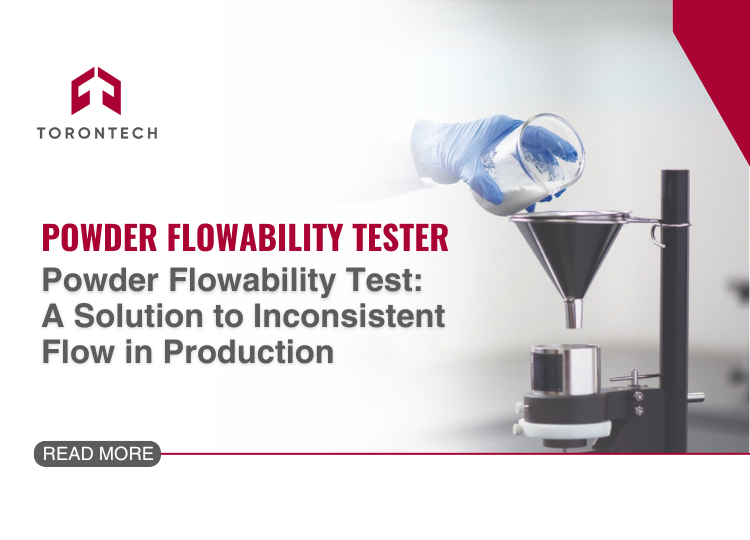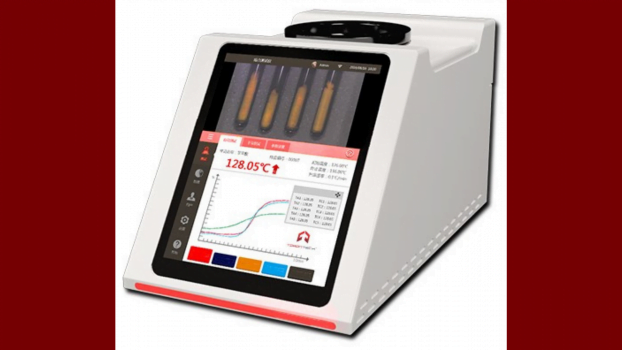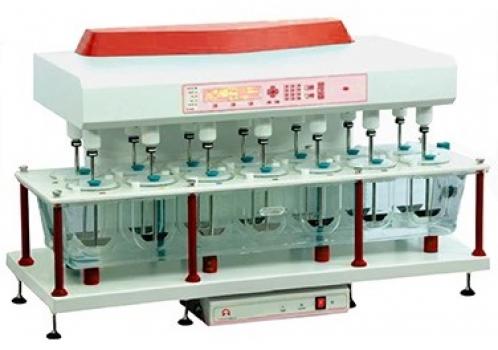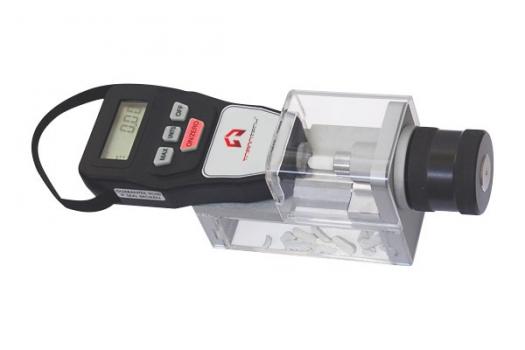Struggling with powders that clump or flow inconsistently can disrupt production and compromise quality. This is where a powder flowability test becomes Important. These methods ensure smooth operations and consistent results. But what exactly is flowability, and how can you test it?
In this article, we’ll explore key testing methods, tools, and tips to help you ensure consistent powder handling and optimal results.
What is Powder Flowability?
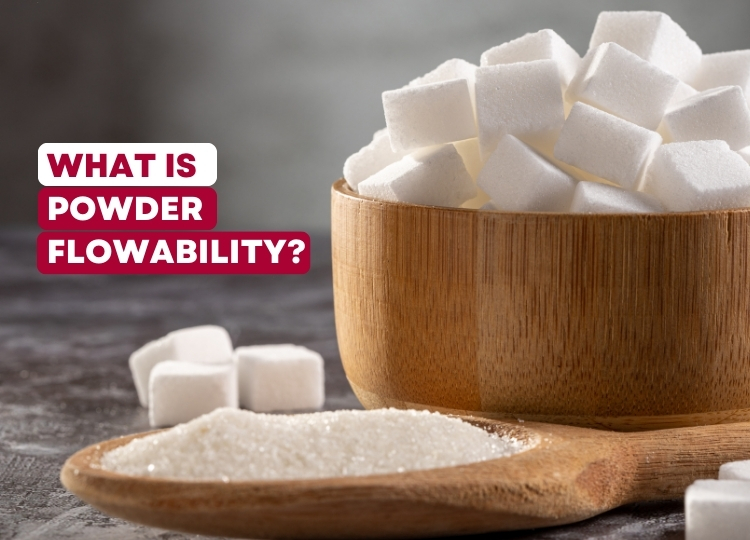
The flowability of powder refers to its ability to move freely and predictably under specific conditions, whether during storage, transport, or processing.
It’s not just a single property, it’s influenced by factors like particle size, shape, and texture, as well as the equipment used to handle it. This makes the flowability of powder test an essential step in industries like pharmaceuticals, food, and manufacturing, where consistent flow is critical.
Conducting a flowability of powder test helps evaluate how powders behave in various applications. This testing ensures that powders flow smoothly, preventing clumping, sticking, or blockages that can disrupt production processes. Advanced tools like a powder analyzer are often used to measure critical parameters and provide insights into optimizing flow performance.
How to Test the Flowability of Powder?
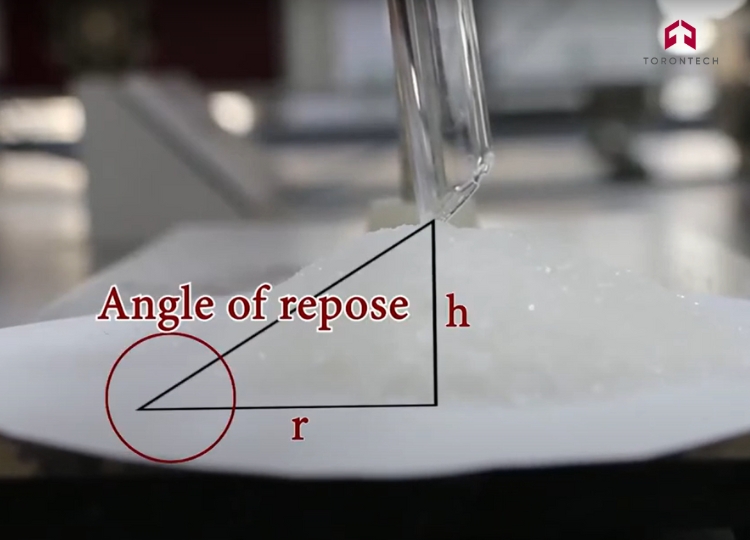
When dealing with powders, understanding their flowability is key to ensuring smooth production processes. A flowability of powder test method provides insights into how powders behave under different conditions. Here are the most common methods you can use, including advanced techniques:
1. Angle of Repose (AOR)
This classic method involves pouring powder into a pile and measuring the angle of its slope. A lower angle indicates better flowability, making this a quick and easy way to get an initial understanding of your powder’s behavior.
2. Flow Through an Orifice
This method measures the time it takes for a powder to pass through a specific-sized opening. It’s an effective way to evaluate flow rate and identify potential clogs or inconsistencies in real-world scenarios.
3. Powder Avalanching
Using specialized equipment, this technique assesses how powders behave when in motion, mimicking avalanching conditions. It’s particularly useful for understanding dynamic flow properties, such as how powders respond to vibrations or tilting.
4. Powder Rheometry
This advanced method evaluates the flow behavior of powders under controlled stress and strain. Powder rheometers provide detailed insights into how powders respond to different forces, offering precision for high-sensitivity applications.
5. Shear Cell Testing
If you need precise data on powder flow resistance, shear cell testing is ideal. It measures the forces needed to shear a powder bed under specific conditions. This method is widely used with a powder flowability tester or powder analyzer for detailed analysis.
What is Good Flowability?
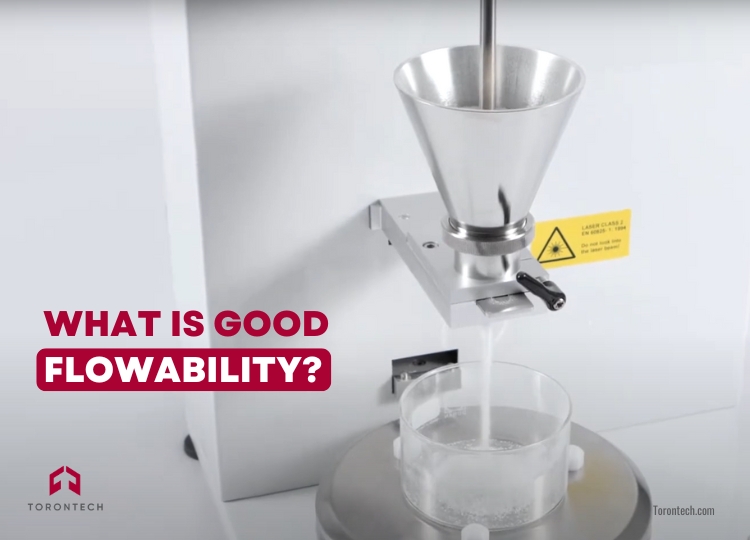
Good flowability is a powder’s ability to move smoothly and predictably without interruptions during handling and processing. It ensures powders can be stored, transported, and used efficiently without issues like clogging, sticking, or inconsistent flow.
Powders with good flowability typically demonstrate:
- Stable Flow Behavior: They move predictably under different conditions.
- Low Compression: Minimal changes in volume under pressure, indicating free movement of particles.
- High Flow Rate: The powder easily passes through openings or equipment.
- Reduced Cohesion: Particles remain separate and resist clumping.
If you use AOR, refer to the table below as a benchmark for the quality of flowability:
How to Calculate Powder Flow Rate
The flow rate of powders is a key factor in many industrial processes, especially in pharmaceuticals, where precise material handling is critical. It reflects how quickly a powder moves through a system or an orifice, providing insights into its efficiency during production. Here’s how to calculate powder flow rate and the factors that influence it.
Flow Rate Calculation Formula
The powder flow rate can be determined using the equation:
Q=M/t
Where:
- Q: Flow rate (e.g., g/s or kg/min).
- M: Mass of powder that flows through the orifice (e.g., grams or kilograms).
- t: Time taken for the mass to flow through the system (seconds or minutes).
For instance, if 500 grams of powder pass through an orifice in 20 seconds, the flow rate would be:
Q=500/20=25 g/s
Theoretical Models of Powder Flow
Research, including studies like Šklubalová and Zatloukal’s work on pharmaceutical powder excipients, highlights the importance of flow equations in understanding powder behavior. They suggest that the flow rate is influenced not only by mass and time but also by powder properties and system geometry, leading to variations in flow performance.
Key considerations from their findings include:
- Powder Cohesion: Cohesive powders flow more slowly and irregularly compared to free-flowing powders.
- Compressibility: Highly compressible powders may show reduced flow rates due to packing effects.
- Orifice Diameter: Larger openings allow for faster flow, while smaller ones may restrict movement, especially for cohesive powders.
Factors Affecting Powder Flowability
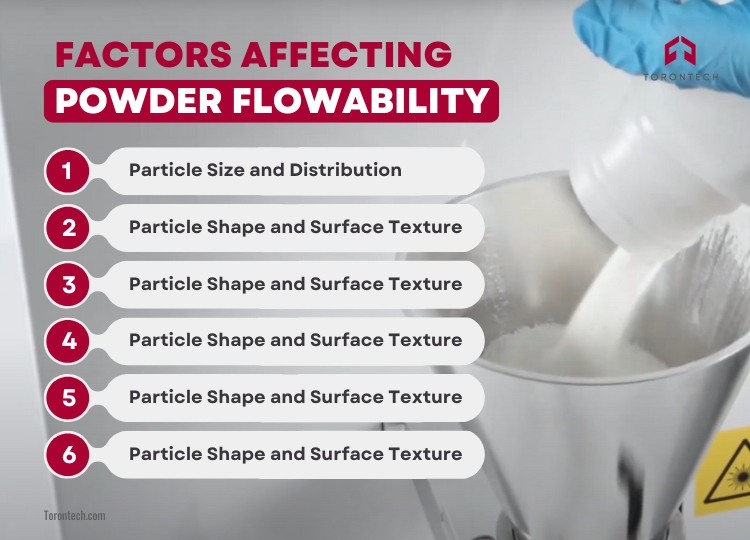
Powder flowability is influenced by a combination of material properties and external conditions. Understanding these factors is essential for predicting and improving the flow behavior of powders during processing, transport, and storage. Below are the key factors that affect powder flowability:
1. Particle Size and Distribution
The size of individual particles and their distribution within a powder batch play a significant role in flowability:
- Smaller Particles: Tend to exhibit higher cohesion due to greater surface area, which can reduce flowability.
- Uniform Distribution: Promotes better flow, while wide size variations can cause segregation and uneven flow.
2. Particle Shape and Surface Texture
The shape and surface characteristics of particles directly affect how they interact:
- Irregular Shapes: Increase inter-particle friction, leading to poor flow.
- Smooth Surfaces: Reduce friction and enhance flowability.
3. Moisture Content
Moisture can significantly alter flow properties:
- Low Moisture Levels: Promote free-flowing powders.
- High Moisture Levels: Lead to clumping and increased cohesion, negatively impacting flowability.
4. Bulk Density and Compressibility
The bulk density of a powder, along with its ability to compress under pressure, affects its flow:
- Low Compressibility: Indicates better flow, as particles resist packing.
- High Compressibility: Suggests cohesive powders that may clog equipment.
5. External Factors
Environmental and operational conditions also impact powder flow:
- Humidity: Can increase moisture content, affecting flowability.
- Vibration: May either enhance or hinder flow, depending on the powder properties.
- Equipment Design: The geometry of hoppers, funnels, and processing systems influences how powders move.
6. Inter-Particle Forces
Cohesion and adhesion between particles are driven by forces such as:
- Van der Waals Forces: Significant in fine powders, reducing flowability.
- Electrostatic Forces: Can cause particles to stick together, especially in dry environments.
Improving Powder Flowability
When powders exhibit poor flowability, such as clumping, sticking, or uneven discharge, these issues can disrupt processes and lead to downtime. Here are effective strategies for improving powder flowability:
1. Granulation and Particle Modification
Adjusting particle size and shape can significantly improve flow:
- Granulation: Converts fine powders into larger, uniform granules that flow more easily.
- Particle Coating: Adds a smooth layer to reduce friction and cohesion between particles.
2. Reduce Moisture Content
Excess moisture can cause powders to clump and stick. To minimize this:
- Use drying systems to lower moisture levels.
- Store powders in controlled environments with low humidity.
3. Add Flow Aids or Anti-Caking Agents
Incorporating additives can enhance powder flow:
- Flow Aids: Reduce friction and cohesion by creating a barrier between particles.
- Anti-Caking Agents: Prevent clumps by absorbing excess moisture.
4. Optimize Equipment Design
The geometry and design of handling systems can influence powder flow:
- Hoppers and Funnels: Ensure smooth walls and angles to prevent sticking.
- Vibration Systems: Add controlled vibrations to facilitate consistent discharge.
5. Use Advanced Testing Equipment
Regular testing helps you monitor and improve flowability:
- Powder Flowability Test Equipment: Analyze flow properties such as cohesion, angle of repose, and bulk density.
- Powder Analyzers: Provide real-time data to identify flow issues and recommend adjustments.
6. Manage External Conditions
Environmental factors can impact powder flowability:
- Maintain optimal temperature and humidity in storage areas.
- Reduce electrostatic buildup by grounding equipment and using conductive materials.
Closing Thoughts
The powder flowability test is a vital step in ensuring efficient production processes, minimizing disruptions, and maintaining consistent product quality. By identifying flow issues such as clumping, sticking, or irregular discharge, this test helps industries like pharmaceuticals, food, and manufacturing optimize their operations and avoid costly inefficiencies.
If you’re looking to enhance your testing capabilities, Torontech’s Powder Flowability Tester offers a comprehensive solution. Designed to deliver precise and repeatable results, it helps you identify and resolve flow issues with ease. Explore our product range here and take the next step toward optimizing your powder handling processes.
Frequently Asked Question (FAQ)
2. Our powders often cause blockages. What is the most effective approach to improving their flowability?
The most effective approach begins with accurate diagnosis. You need to know if the problem is moisture, particle shape, or electrostatic forces before you can apply the right solution. Our Powder Flowability Testers are designed to provide the clear, quantitative data needed to make that distinction. Once you have reliable data, you can confidently implement the correct strategy, whether it's adjusting your process, adding a specific flow aid, or redesigning equipment.
3. With different methods like Angle of Repose and Shear Cell testing, how do we determine the right one for our QC lab?
The right method depends entirely on your goal. Angle of Repose is a fast, simple method perfect for basic screening. However, if you're designing new equipment or solving a complex formulation issue, you'll need the detailed, actionable data that comes from Shear Cell testing. This is a common challenge, and our expert team often helps clients select the right instrument from the Torontech range to ensure their testing method aligns perfectly with their quality and R&D objectives.
4. What is the strategic advantage of bringing powder flowability testing in-house instead of relying solely on supplier specifications?
Bringing testing in-house gives you ultimate control over your quality assurance. Supplier data is a useful starting point, but it doesn’t account for how transport and storage conditions can alter a powder's behavior. With a robust instrument like the Torontech Powder Flowability Tester on your bench, you empower your team to verify every incoming batch, troubleshoot production issues in real-time, and innovate with confidence, knowing you have full control over your material data.
5. How critical is our choice of testing equipment for ensuring reliable and actionable flowability data?
Your choice of equipment is absolutely critical, as the quality of your data is entirely dependent on the quality of your instrument. An unreliable tester can provide misleading information, leading to poor process decisions that cost time and money. That’s why at Torontech, we focus on engineering robust systems that deliver exceptional precision and repeatability. When you invest in our equipment, you’re investing in data you can trust to make critical business decisions with confidence.
References:
- Tan, G., Morton, D., & Larson, I. (2015). On the Methods to Measure Powder Flow. Current Pharmaceutical Design, 21(40), 5751–5765. https://doi.org/10.2174/1381612821666151008125852
- M. Peleg, “Flowability of food powders and methods for its evaluation – A review”¸ J. of Food Process Engineering (1977) 303-328.
- J.K. Prescott and R.A. Barnum, “On powder flowability”, Pharmaceutical Technology 24 (10): 60-84. (2000)
- Šklubalová, Z., & Zatloukal, Z. (2011). Flow rate and flow equation of pharmaceutical free-flowable powder excipients. Pharmaceutical Development and Technology, 18(1), 106–111. https://doi.org/10.3109/10837450.2011.640686
- Shah, D. S., Moravkar, K. K., Jha, D. K., Lonkar, V., Amin, P. D., & Chalikwar, S. S. (2023). A concise summary of powder processing methodologies for flow enhancement. Heliyon, 9(6), e16498. https://doi.org/10.1016/j.heliyon.2023.e16498

